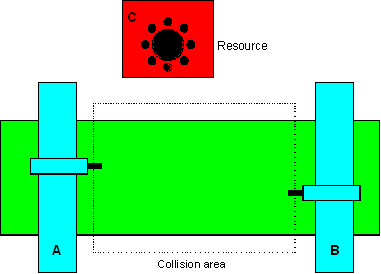Channel synchronization
When operating a multi-channel control (particularly in the case of n > 2), situations may occur in which it is essential that specific run sequences be complied with between channels.
 Fig.78: Example application, double-column machine with tool changer
Fig.78: Example application, double-column machine with tool changerThe example in Fig. 77 shows such an application in which two machining units (A and B) share a common machining space. Likewise, both machines use the tool changer resource (C). To avoid collisions with such a machine configuration, the NC-programs of the various channels of the control system must be synchronized with each other at specific points. In the above case for example, unit A may not enter the collision space for as long as unit B is still in it. Likewise, unit B may not use the tool changer if unit A is currently accessing it.
The time sequence on the two channels of the control system, shown in Fig. 78, results for instance for access to the tool changer resource.
 Fig.79: Sequence for shared access to a resource
Fig.79: Sequence for shared access to a resourceThe required synchronization is based on sending and waiting for signals and is performed via the NC-commands described below in the NC programs.